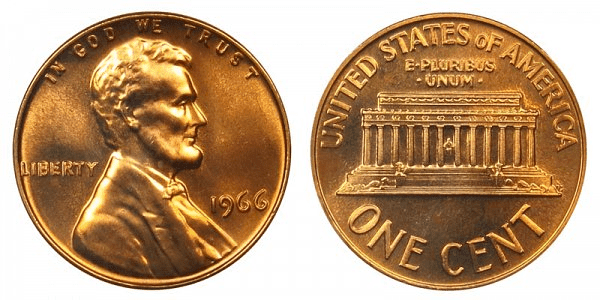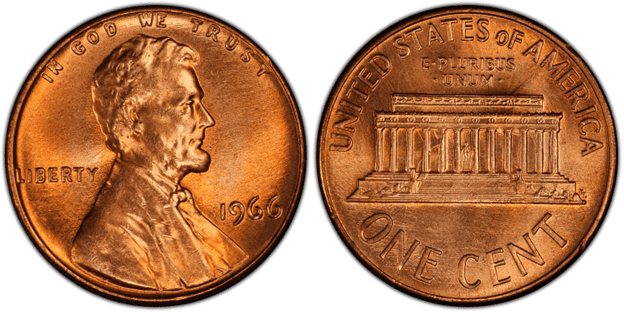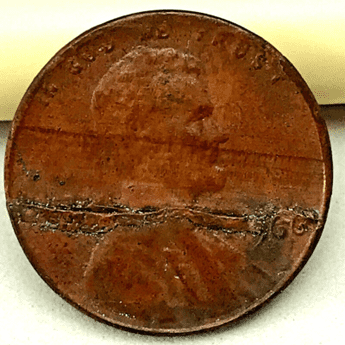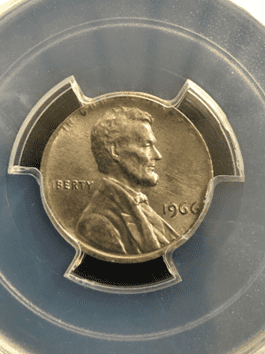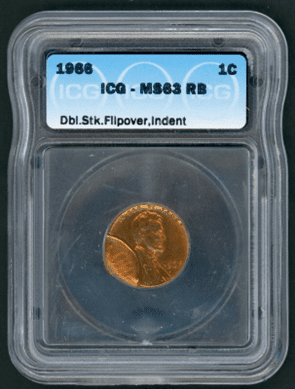What Is the 1966 Lincoln Penny Made Of?
The 1966 Lincoln penny is made of 95% copper and 5% zinc. The same composition is given to Lincoln pennies made from 1909 to 1942 and from 1944 to 1982.
Here’s a quick look at their specifications:
- Value – one cent
- Mass – 2.5 g
- Diameter – 19.05 mm
- Edge – plain
- Years of minting – from 1909 to present
The word penny is quite interesting. The official name of the five-cent coin is actually Lincoln cent, but a lot of people call it Lincoln penny. Way back in the time of the colonial period, people used different types of coins. In the United States, the word penny was adopted, which refers to the British penny, the smallest value of a coin in British pound.

photo source: USA Coin Book
When it comes to design, the obverse includes the image of Abraham Lincoln, the 16th president of the United States. The inscriptions include the following:
- IN GOD WE TRUST
- LIBERTY
- 1966
On the reverse, you will find the front view of the Lincoln Memorial. The inscriptions include the following:
- UNITED STATES OF AMERICA
- E PLURIBUS UNUM
- ONE CENT
When the Lincoln cent was first struck, it retained the two stalks of wheat design for the reverse. Thus, it was called the wheat pennies from 1909 to 1958. It was just after that time that the Lincoln Memorial was added.
The obverse was designed by Victor D. Brenner. Originally, it was Augustus Saint-Gaudens who was tasked to redesign the cent. Regrettably, he died in August 1907 and wasn’t able to submit his design.
1909 is the centennial year of Lincoln’s birth. So, it was only fitting for him to be added to the one-cent coin. In fact, the Lincoln cent was the first widely circulated coin with a face of a president in the United States.
1966 Lincoln Penny Varieties
In 1966, there was only one US Mint that produced the Lincoln penny, which was the Philadelphia Mint.
1966 P Lincoln Penny
Year of minting: 1966
Mint Mark: Not present
Place of minting: Philadelphia
Quantity produced: 2,188,147,783
Face Value: $0.01 (one cent)
Price: $0.01 to $12.00 (or more)
Mass: 2.5 grams
Edge: Plain
Designer: Victor D. Brenner (obverse) / Frank Gasparro (reverse)
Composition: 97.5% zinc and 2.5% copper
Diameter: 19.05 mm
Thickness: 1.52 mm

photo source: PCGS
The Philadelphia Mint produced 2,188,147,783 pennies in 1966. These pennies don’t have a mint mark. The average price of this coin may range from $0.01 to $12.00. The Lincoln penny can be more expensive when sold in the open market.
1966 P cents with grades of MS 66 and MS 67 are difficult to find. They can be very expensive as well.
List Of 1966 Lincoln Penny Errors
The 1966 Lincoln penny comes with various errors during the minting process. It should not come as a surprise considering that there are billions of these coins.
There are different reasons for mint error coins to come about. One of the primary reasons would be the wear and tear of the minting equipment. There are also times when accidents and human error happens.
Here’s an example of a 1966 Lincoln penny error:

photo source: eBay
This is called the rim-to-rim lamination mint error. This happens when a foreign material or impurities such as debris, slab, and metal dust becomes trapped inside the metal planchet. Because of the impurity, it doesn’t mix well with the coin’s base metal.
Another example is this one:

photo source: eBay
What’s special about this coin is that the planchet used was meant for the dime. A dime is made of copper and nickel. The penny is made of copper and zinc. So, this is really a special type of coin because of the error.
The next example is a 1966 penny with a double-struck flip over indentation:

photo source: eBay
As you can see above, the coin was struck twice. This happened because the coin was not properly flipped. As a result, the strike that is supposed to be for the reverse was struck to the obverse.
Another common error is the doubled die error. This happens when the coin was struck twice by the die. The strike almost landed on the same spot with just a very small difference. That’s why doubled-die errors can be difficult to detect. However, some doubled-die errors are too obvious. You’ll see a doubling of letters, numbers, and other elements.
Here’s an example:

photo source: eBay
You’ll see a doubling on the words, “IN GOD WE TRUST.” Experts needed to use microscopes or magnifying glasses to find these doubling elements.
How Much Is the 1966 Lincoln Penny Worth Today?
The ordinary 1966 Lincoln penny’s worth is the same as its face value, which is $0.01. Its melt value is slightly higher at $0.0226.
As this might be the case, there are still Lincoln pennies issued in 1966 that are worth a few hundreds and thousands of dollars.
To give you an idea, here’s a 1966 Lincoln Penny values chart:
| Coin | Condition | Grade | Mintage | Value |
| 1966 D Lincoln penny | Circulated/mint | Not graded | 2,188,147,783
|
$0.01 to $12.00 |
| 1966 D Lincoln penny | Uncirculated/mint | MS-65 | 2,188,147,783
|
$9 to $25 |
| 1966 D Lincoln penny | Uncirculated/mint | MS-66 | 2,188,147,783
|
$21 to $36 |
| 1966 D Lincoln penny | MS-67 | 2,188,147,783
|
$282 to $1,528 |
How Does The Grading System Work?
The Sheldon Scale is used by numismatists to provide a numerical value to coins. The Sheldon Scale goes from poor (P-1) to perfect mint state (P-1) (MS-70). Coins were originally evaluated using words to reflect their condition (Good, Fair, Excellent, Etc.). Unfortunately, coin collectors and dealers had different ideas about what each of these terms represent.
Professional numismatists joined together in the 1970s and established CoinGrading standards. These numismatists now assign grades at key places on the seventy-point scale, using the most regularly utilized numeric points in conjunction with the original adjective grade. The following are the most common coin grades:
-
-
- (P-1) Poor – Indistinguishable and probably damaged; if used, must have a date and mintmark; otherwise, rather battered.
- (FR-2) Fair – Nearly smooth, but without the damage that a coin graded Poor often possesses. The coin must have enough detail to be identified.
- (G-4) Fair – Inscriptions have merged into the rims in some areas, and important elements have been mostly erased.
- (VG-8) Very Good- A little weathered, but all of the primary design elements are visible, albeit faintly. There is little if any, central detail left.
- (F-12) Good – The item is very worn, yet the wear is even, and the overall design details stand out clearly. Rims are almost completely isolated from the field.
- (VF-20) Very Fine – Moderately weathered, with some finer features still visible. The motto or all letters of LIBERTY are readable. Both sides of the coin have entire rims that are separated from the field.
- (EF-40) Extremely Fine – Gently used; all gadgets are visible, and the most important ones are bold. The finer details are bold and clear, however, light wear may be seen.
- (AU-50) Uncirculated – Slight evidence of wear on the coin’s design’s high points; may have contact marks; eye appeal should be adequate.
- (AU-58) Uncirculated Choice – Slight traces of wear, no severe contact marks, almost full mint shine, and great eye appeal.
- (MS-60) Mint State Basal – Strictly uncirculated; no indication of wear on the coin’s highest points, but an unsightly coin with reduced luster, visible contact marks, hairlines, and other flaws.
- (MS-63) Mint State Acceptable – Uncirculated, but with contact scratches and nicks, little reduced shine, but otherwise appealing appearance. The strike is weak to average.
- (MS-65) Mint State Choice – Uncirculated with great mint shine, very little contact blemishes, and exceptional eye appeal. The strike is unusually severe.
- (MS-68) Mint State Premium Quality – Uncirculated with superb luster, no obvious contact marks to the naked eye, and exceptional eye appeal. The strike is quick and appealing.
- (MS-69) Almost Perfect Mint State – Uncirculated with perfect brilliance, a sharp and appealing strike, and extremely good eye appeal. A near-perfect coin with minor imperfections in the planchet, strike, and contact markings (seen only under 8x magnification).
- (MS-70) Mint State Perfect – Under 8x magnification, there are no tiny imperfections discernible; the strike is crisp, and the coin is perfectly centered on a beautiful planchet. Rarely seen on a coin, this coin is bright and whole, with original luster and exceptional eye appeal.
-
Are There Any Rare 1966 Lincoln Penny?
There are over 2 billion 1966 Lincoln pennies produced by the Philadelphia Mint. So, it’s not really a rare coin. However, coins with unique errors are considered rare. Aside from that, coins with grades of at least MS 66 are considered extremely rare.
Where To Buy Or Sell 1966 Lincoln Penny?
You can buy or sell 1966 Lincoln pennies in coin stores and antique shops. You can also find private collectors who may be interested in buying your coins or selling you their coins.
Some of the rarest 1966 Lincoln coins are found in auctions. Thus, you may also want to consider joining auctions and you’ll have a good chance you’ll find 1966 Lincoln pennies.
If you are able, look for local clubs of collectors. They can help you find the coins that you like. The wider your network is, the more chances you’ll have in finding your penny.
Aside from that, you can try to contact coin grading service providers. They have a long list of contacts that could offer you their 1966 Lincoln cent. Plus these providers might also have coins to sell you.
Of course, if you want to quickly buy or sell 1966 Lincoln penny, then you should try searching online. The most common websites to go to would be Amazon, Etsy, and eBay. They are free to use. Simply create an account and you should be up and running.
You can go to Google or other search engines. You can do a quick search and you’ll find websites that specialize in selling and buying coins.
Be sure that you transact with reputable and trusted people. Remember, the internet is full of people who will try to scam you. So, always do a background check.
FAQs
What 1966 penny is worth $3000?
The 1966 penny that is worth $3,000 would be the one with a grade of at least MS 67. Aside from that, coins with rare errors and still in good condition might be sold for as much as $3,000 in the open market.
Is there a rare 1966 penny?
Yes, there are rare 1966 pennies. These rare pennies are usually coins with unique errors. Coins with grades of MS 66 and above are also considered rare.
What is the value of a 1966 doubled-die penny?
The value of a 1966 doubled-die penny may range from $10 to $700. It can be more expensive if the penny is still in good condition and has unique attributes.
How do I know if my penny is worth money?
There are different factors that affect the value of a penny. You need to be familiar with what makes a coin valuable. For example, you should be able to know the type, date, grade, and mintmark. All these can affect the value of your coin.
Aside from that, you can get in touch with a coin grading service provider. They can help you know the condition of your coin and accurately tell you the value of your coin.

